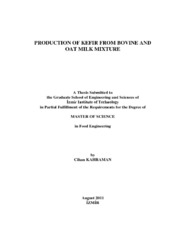Please use this identifier to cite or link to this item:
https://hdl.handle.net/11147/3094Full metadata record
| DC Field | Value | Language |
|---|---|---|
| dc.contributor.advisor | Korel, Figen | - |
| dc.contributor.author | Kahraman, Cihan | - |
| dc.date.accessioned | 2014-07-22T13:50:51Z | - |
| dc.date.available | 2014-07-22T13:50:51Z | - |
| dc.date.issued | 2011 | - |
| dc.identifier.uri | http://hdl.handle.net/11147/3094 | - |
| dc.description | Thesis (Master)--Izmir Institute of Technology, Food Engineering, Izmir, 2011 | en_US |
| dc.description | Includes bibliographical references (leaves: 89-101) | en_US |
| dc.description | Text in English; Abstract: Turkish and English | en_US |
| dc.description | xii, 119 leaves | en_US |
| dc.description.abstract | During recent years non-dairy milk types such as cereal and grain milks have been an increased demand from consumers due to their functional properties. The cereal and grain milks do not contain cholesterol or lactose; therefore, these milk types are preferred by consumers who are vegetarians, have special diets or are lactose intolerant.In this study, different concentrations of oat milk (0, 15, 30, 45, and 60%), blueberry aroma(9, 12, 15, 18, and 21%), and kefir culture(1, 2, 3, 4, and 5%) were used for the optimization of the kefir production and samples were stored at 4C for 21 days. The response surface methodology was used for the optimization process. Sensory characteristics, the pH changes and microbial characteristics of the kefir samples were determined during storage and the concentrations of the oat milk, blueberry aroma and kefir culture for the best three kefir products were chosen based on the optimization results According to optimization results, three kefir samples which contained the highest level of oat milk with optimum organoleptic characteristics, optimum pH and optimum microbial counts were selected and produced. Based on the organoleptic results, kefir samples composed of 20% oat milk, 4% kefir culture and 10% aroma concentration, were produced. According to the pH results kefir samples within 15% oat milk, 4% kefir culture and 9% aroma concentration were produced. Based on the microbiological results kefir samples within 30% oat milk, 3% kefir culture and 15% aroma concentration were produced. The pH, titratable acidity, dry matter, fat, protein, phenol content, beta-glucan content, whey off, viscosity, volatile and organic acid profile of samples, color change, microbiological characteristics and sensory characteristics of these samples were investigated during 21 days of storage. | en_US |
| dc.language.iso | en | en_US |
| dc.publisher | Izmir Institute of Technology | en_US |
| dc.rights | info:eu-repo/semantics/openAccess | en_US |
| dc.subject.lcsh | Kefir | en |
| dc.subject.lcsh | Fermented milk | en |
| dc.title | Production of Kefir From Bovine and Oat Milk Mixture | en_US |
| dc.type | Master Thesis | en_US |
| dc.institutionauthor | Kahraman, Cihan | - |
| dc.department | Thesis (Master)--İzmir Institute of Technology, Food Engineering | en_US |
| dc.relation.publicationcategory | Tez | en_US |
| dc.identifier.wosquality | N/A | - |
| dc.identifier.scopusquality | N/A | - |
| item.openairecristype | http://purl.org/coar/resource_type/c_18cf | - |
| item.cerifentitytype | Publications | - |
| item.fulltext | With Fulltext | - |
| item.languageiso639-1 | en | - |
| item.grantfulltext | open | - |
| item.openairetype | Master Thesis | - |
| Appears in Collections: | Master Degree / Yüksek Lisans Tezleri | |
Files in This Item:
| File | Description | Size | Format | |
|---|---|---|---|---|
| 413332.pdf | 2.87 MB | Adobe PDF |  View/Open |
CORE Recommender
Page view(s)
392
checked on Apr 28, 2025
Download(s)
540
checked on Apr 28, 2025
Google ScholarTM
Check
Items in GCRIS Repository are protected by copyright, with all rights reserved, unless otherwise indicated.